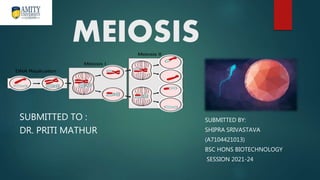
Meiosis: A Special Cell Division
- 1. MEIOSIS SUBMITTED TO : DR. PRITI MATHUR SUBMITTED BY: SHIPRA SRIVASTAVA (A7104421013) BSC HONS BIOTECHNOLOGY SESSION 2021-24
- 2. CELL CYCLE It includes INTERPHASE and M PHASE. Interphase- preparation for cell division. G1 phase S phase G2 phase M phase or meiotic phase- cell division. Karyokinesis cytokinesis
- 3. Meiosis - A special type of cell division that occurs in order to produce haploid cells (gametes). - Meiotic cell division was first time described by Van Beneden in 1883. - During this type of cell division, the genetic material of a diploid germ cell undergoes two nuclear divisions and resulting into four haploid daughter cells. - Each daughter cell has half of the number of chromosomes as present in the parent cell. - Meiosis includes two successive nuclear divisions – Meiosis1- Reductional Division. Meiosis2- Equational Division.
- 4. Interphase -The interphase just prior to the entry of cell into meiosis is known as pre meiotic interphase. -G1 phase Protein synthesis. Replication of cell organelles. -S phase Centrosome replicates. DNA duplication chromatid formation. -G2 phase Protein synthesis . Replication of mitochondria and chloroplast.
- 5. Meiosis-1 -Meiosis 1 separates homologous chromosomes and produce two cells with haploid chromosome number (n) for that reason it is known as reductional division. It consist of four stages – Prophase1 Metaphase1 Anaphase1 Telophase1
- 6. Prophase 1 It is the longest phase takes about 85-90 percent of total time for meiosis and also much more complex. It is divided into five stages – Leptotene Zygotene Pachytene Diplotene Diakinesis
- 10. Leptotene -The first stage of prophase 1 is called Leptotene or leptonema -All the chromosome begin to condense, so they become visible as fine thread. -There is marked increase in the nuclear volume. -A process of homology search which is essential to initial pairing of homologs begin during Leptotene.
- 11. Zygotene -This stage begins with the initiation of pairing between homologous chromosome and it ends with complete pairing. -The process of pairing (at end to end) between homologous chromosomes is known as Synapsis (homologous dyads). -The synaptonemal complex is formed during these zygotene stage. -At the completion of zygotene ,the paired homologs take the form of bivalents. -The number of bivalents in each species is equal to the haploid number.
- 12. Pachytene - The process of synapsis is complete. - The two homologous of each bivalent appears to be attached with each other at one or more points. These attachments are known as chiasmata. - Crossing over is a precise breakage swapping and remain between two non sister chromatids. - Cross over makes new gene combinations and which are an important source of genetic variation in populations.
- 13. Diplotene - DNA recombination is complete. - The chromatids continue to shorten and thicken and the four sister chromatids in a group is called a tetrad. - The synaptonemal complex begins to breakdown. -The paired chromatids begin to pull apart, causing the strands to separate longitudinally. - The chiasmata tend to become terminalized as the meiotic prophase continues.
- 14. Diakinesis - The chromosome becomes shorter and thicker due to condensation. - Nuecleolous and nuclear envelope disappear toward the end of diakinesis . - The spindle apparatus becomes organised. - The centrioles migrate away from one another.
- 15. Metaphase- I - All the bivalents migrate within a cell to metaphase plate. - One homologue is pulled above the metaphase plate,the other below. - The centromeres of homologues chromosome of each bivalent stresss out on either side - The centrioles are at opposite poles of the cell. - Spindle fibres from one pole of the cell attach to one chromosome and spindle fibre from the opposite pole attach to the homologues chromosome.
- 16. Anaphase- I Chromosomes move to the opposite poles The microtubules and the kinetochore fibres interact, which cause the movement. A difference between mitosis and meiosis is that sister chromatids remain joined after metaphase in meiosis-I, whereas in mitosis they separate. During anaphase I original chromosomes separate , so reduction in number of chromosomes from 2n to n number yet the sister chromatids remain together.
- 17. Telophase- I The homologous chromosomes complete their migration to the poles shortning of spindle. The nuclear envelope organized around the two groups of chromosomes. The nucleolus also reappears. Cytokinesis It involves the formation of a cleavage furrow, resulting in the pocketing of the cell into two cells. At the end of telophase I and cytokinesis , two daughter cells are produced , each with one half of the number of chromosomes( haploid set of replicated chromosomes ) of the original parent cell.
- 19. Interkinesis Interkinesis (interphase II ) is similar to interphase. Meiosis II Meiosis II is the second part of the meiotic process. It consist prophase II ,metaphase II, anaphase II, telophase II and cytokinesis.
- 21. Prophase II Each dyad is composed of a pair of sister chromatids attached by a common centromere. Metaphase II Centromeres are positioned at the equatorial plate. Anaphase II Centromeres divide and the sister chromatid of each dyad are pulled to opposite poles.
- 22. Telophase-II One member of each pair of homologous chromosome present in each pole. Each chromosome is referred as monad ( a combination of maternal and paternal genetic information). Nuclei reform around chromosome at the poles. Following cytokinesis ,finally four haploid gametes result from a single meiotic event.
- 23. Functions of Meiosis Production of haploid gametes ; so that fertilization restores the normal somatic chromosomes number. Production of genetic variation. Recombination between the linked genes due to crossing over during pachytene stage. In sexually reproducing organism meiosis is essential for continuity of generation because it results in the formation of male and female gametes and union of each gametes leads to the development of zygotes and thereby new individuals.
- 24. Thank you